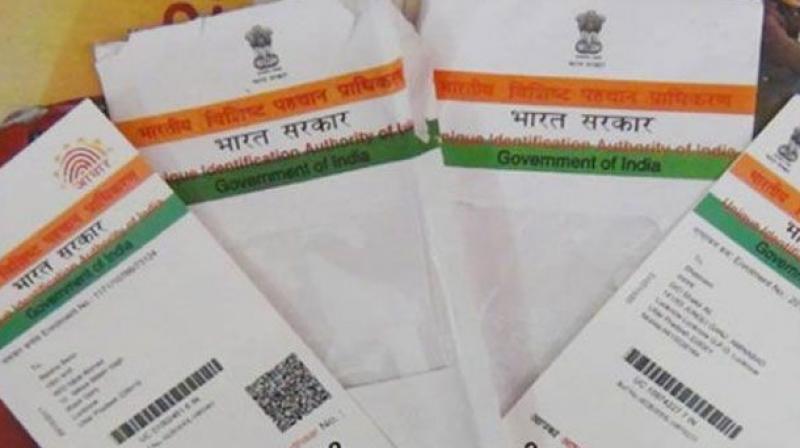Aadhaar overdrive may set off huge chaos

The way the Narendra Modi government has been trying to push the use of the Aadhaar number, or UID, into all facets of life show a desperation that is unnerving. The latest two instances of its intentions are the step to link a person’s PAN number, used in many financial dealings, specially in the payment of taxes, with UID, to stop the use of “duplicate” PAN numbers and the unbelievable step to stop all bank transactions by the end of the year unless they are backed by Aadhaar.
If the courts don’t step in and stop this stupidity, it will create unprecedented chaos in the banking system. People won’t be able to pay their taxes or withdraw their money from banks or issue cheques. The disruption will be far more intense than that caused by demonetisation, and its economic effects far more sinister. The new rules issued by the finance ministry require existing bank account holders to submit their Aadhaar details to banks by December 31, 2017, failing which the accounts will “cease to be operational”. It was a coup by the backdoor, and the stealthiness of the process was confirmed as the rules were gazetted a full fortnight before the news of it leaked out and a week before the Supreme Court ruled on linking PAN numbers to Aadhaar.
The insidious thing about UID was that it was introduced as a money bill earlier in the year, without informing MPs or having a discussion in Parliament on making Aadhaar mandatory for the filing of income-tax returns. The bill also said those who file I-T returns without an Aadhaar-linked PAN card will have their PAN declared invalid. This has been the story of Aadhaar and UID so far, from being a purely voluntary registration to increasingly assuming more functions till it becomes mandatory — from things like getting a marriage registered, to free mid-day meals for schools, getting subsidised gas connections to rehabilitating bonded labour or prostitutes.
The reason given by the government on why it is necessary to insist on the Aadhaar number in addition to the PAN card was the alleged vast duplication of PAN cards which made it easy for people to avoid paying tax. But going by the government’s own figures, the number of fake cards is just 0.4 per cent of the total number. While this may not be insubstantial, given that a few crore PAN cards have been issued, it does compare to the discrepancies within UID itself.
These are not fully known since the Unique Identification Authority of India, the body that oversees Aadhaar, citing national security, refused to answer a Right to Information request on the number of fake or duplicate Aadhaars that are in existence. Besides this, UIDAI has thousands of private operators who collect data and often sell it. The UIDAI has since 2010 suspended over 34,000 “operators” — private individuals who carry out enrolment for Aadhaar — for “polluting” the Aadhaar database. It has also received hundreds of complaints over issues like two Aadhaars registered for the same individual, fake data and Aadhaars being registered even for animals and gods. In Andhra Pradesh alone, out of 48.8 lakh cases recorded, 2.3 lakh were false. In 2013, it was reported that UIDAI had to cancel 3.84 lakh fake Aadhaar cards because of a specific procedural loophole. Obviously, the system is riddled with major faults and inconsistencies, and cannot be more foolproof than PAN. Moreover, in Telangana, for instance, an alarming 36 cent of people applying for the rural job guarantee scheme failed to authenticate their identities with fingerprints. The Economic Survey shows authentication failure rates as “49 per cent for Jharkhand, six per cent for Gujarat, five per cent for Krishna district in Andhra Pradesh and 37 per cent for Rajasthan... Failure to identify genuine beneficiaries results in exclusion errors”.
While opposing Aadhaar, Supreme Court lawyer Usha Ramanathan wrote: “It is possible that, given the enormous porosity and magnitude of untried technologies being deployed in the unique identification (UID) project, it may crumble or implode... But by then, many systems may be destroyed which will be difficult to resurrect, many vulnerabilities created, many people made into ghosts and duplicates, and many a problem erected as testimony to a project that should never have been.”
Given the many vulnerabilities in society that an experiment like Aadhaar reveals, it is surprising that so many people with a taste for power should stand so solidly behind it. It can’t be a matter of administrative efficiency or simply of ensuring that the poor get a better deal. Coercion has been used throughout in the Aadhaar project. At the outset, the UPA government that introduced the idea was restrained in backing the project. Now, as the statements of the finance minister and attorney-general indicate, people are increasingly being compelled to part with their biometrics.
Indian and foreign companies which use this information to beam multiple advertisements into our homes from banks, mobile phone companies and Internet firms are only a part of the story. There are companies which were involved at every stage, from pilot to execution, and from enrolment to control over the database. They have a close relationship with many intelligence agencies of foreign governments. It is difficult to believe, however, that they are powerful enough to influence the policies of a large country like India.
The deliberate intrusion into our lives is to gain more control and information over citizens, by being able to either deny us the benefits to which we are entitled or threatening us that no secrets can be kept from an all-knowing state. It’s a step towards an all-powerful state, with surveillance and monitoring as in George Orwell’s 1984. It is only the courts and the political Opposition that can act as a brake to the increasingly authoritarian tendencies of the government.

